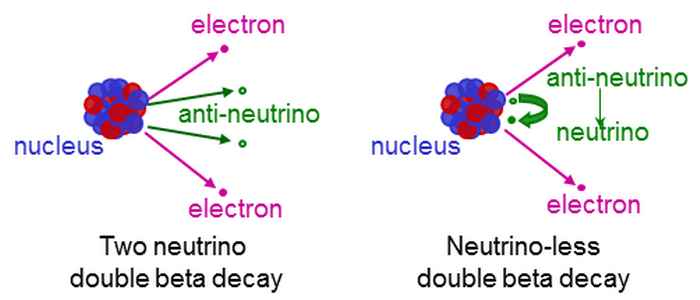Theoreticians zoom in on mysterious double neutron decay
19 March 2021

Theoretician Jordy de Vries of the University of Amsterdam and Nikhef is publishing with colleagues a follow-up to a paper that caused a stir in 2018. In it, they showed that existing nuclear physics calculations on an extremely rare decay overlooked an important effect. Experiments looking for that decay were using the wrong model, was the message.
De Vries: ‘At the time we could indicate that the calculations were wrong, but not how much. Our new paper provides an answer to that, too, with which the real nuclear physicists can get to work.’ The new paper, which can be read on Arxiv, has now been accepted by the journal Physical Review Letters.

In neutrinoless double-beta decay, atomic nuclei fall apart in a special way. In essence, it involves the spontaneous conversion of two neutrons in the atomic nucleus into two protons. What is special about this is that two electrons are also created, new elementary particles that would then emerge from a process in which, in principle, only the quarks in nucleus particles should play a role.
This so-called leptogenesis (electrons are so-called leptons) may once have played a role in the Big Bang and help explain why the current universe consists of matter, and not stable antimatter. The standard model of particle physics does not know how to deal with leptogenesis.
The prerequisite for this rare decay is what physicists call a neutrinoless process. A single neutron in a nucleus can spontaneously disintegrate into a proton and an electron plus a third slightly neutral particle, called an anti-neutrino. That process is called beta decay, and is a commonplace form of radioactivity. In this process, the number of leptons before and after the decay is the same, because the anti-neutrino has the lepton number -1.
But for a process like neutrinoless double-beta decay, nature’s housekeeping book would not be right. There, two neighboring neutrons in a nucleus decay simultaneously, with the antineutrinos they emit in the process destroying each other along the way. As a result, beta decay occurs in the nucleus without the accompanying anti-neutrinos ever being seen.
Theorists are particularly interested in the mutual destruction of the anti-neutrinos. When that happens, these are so-called majorana states: particles that are their own antiparticle. Majorana states have never been demonstrated in an experiment, although states very similar to them can be created in some solids.
The new calculations include the effects for the case where neutrons interact at very short distances (less than 1 femtometer). Older nuclear physics calculations assumed that these contributions would not be significant, but this was shown to be false back in 2018.
Now it is also starting to become clear how much. Still, the new calculations do not yet tell the full story of a real experiment, says De Vries. The problem is that heavy atomic nuclei are used for measurements, such as xenon (also widely used in searches for particles of dark matter from the universe).
De Vries: ‘It is a huge task to do a meaningful calculation on a nucleus with more than a hundred protons and neutrons. The anomaly we pointed out does hold up for a system of about ten nuclear particles. But it is not yet said to hold true for heavy nuclei as well.’ This, he also says, is now being worked on by nuclear physics groups.
The search for clues to neutrinoless double-beta decay has been going on for some time in the underground KEK laboratory in Japan, the Kamland-ZEN experiment with liquid xenon in which physicist Patrick Decowski of Nikhef is also involved. In America there are currently advanced plans for an even larger xenon experiment that searches for the effect, the nEXO experiment that may come to Canada.
To understand the results of those experiments properly, the new calculations are important input. ‘If you measure something, or nothing at all, it doesn’t mean anything until you understand what should be happening.’